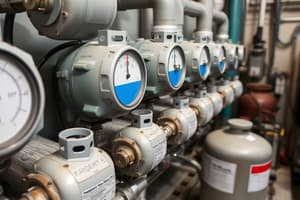Podcast
Questions and Answers
What requirements must a recovery device for small appliances containing CFCs, HCFCs, and HFCs meet?
What requirements must a recovery device for small appliances containing CFCs, HCFCs, and HFCs meet?
Recovering 90% of the refrigerant when the compressor is operating or achieving a 4 inch vacuum under the conditions of AHRI 740.
Which of the following refrigerants is very high pressure and generally does NOT need to be recovered?
Which of the following refrigerants is very high pressure and generally does NOT need to be recovered?
- R-600a
- R-22
- R-744 (correct)
- R-134a
Which of the following is an approved substitute refrigerant for new household refrigerators, freezers, and combination refrigeration/freezers?
Which of the following is an approved substitute refrigerant for new household refrigerators, freezers, and combination refrigeration/freezers?
- R-600a (correct)
- R-134a
- R-22
- R-744
When servicing a small appliance found to be leaking, it is mandatory to repair the leak.
When servicing a small appliance found to be leaking, it is mandatory to repair the leak.
What standard must equipment used to recover CFC, HCFC, and HFC refrigerant from small appliances meet?
What standard must equipment used to recover CFC, HCFC, and HFC refrigerant from small appliances meet?
Nitrogen used to pressurize or blow debris out of a system after recovering refrigerant may be vented to the ambient air.
Nitrogen used to pressurize or blow debris out of a system after recovering refrigerant may be vented to the ambient air.
What acids can CFC and HCFC refrigerants decompose into at high temperatures?
What acids can CFC and HCFC refrigerants decompose into at high temperatures?
It is essential to take measures to help release trapped CFC, HCFC, or HFC refrigerants from the compressor oil when using a self-contained recovery device.
It is essential to take measures to help release trapped CFC, HCFC, or HFC refrigerants from the compressor oil when using a self-contained recovery device.
What type of products are included in EPA's definition of a 'small appliance'?
What type of products are included in EPA's definition of a 'small appliance'?
What must technicians recover when using a self-contained recovery device on a system with an operating compressor?
What must technicians recover when using a self-contained recovery device on a system with an operating compressor?
Which condition requires accessing both the high and low side of the system for refrigerant recovery?
Which condition requires accessing both the high and low side of the system for refrigerant recovery?
What condition can cause excessive pressure on the high side of a self-contained recovery device?
What condition can cause excessive pressure on the high side of a self-contained recovery device?
What action should be taken in case of a large refrigerant leak in an enclosed area?
What action should be taken in case of a large refrigerant leak in an enclosed area?
How can low loss fittings on refrigerant recovery devices be described?
How can low loss fittings on refrigerant recovery devices be described?
Why can a very large refrigerant leak cause suffocation?
Why can a very large refrigerant leak cause suffocation?
At what pressure cannot the recovery procedure begin after installing and opening a piercing access valve?
At what pressure cannot the recovery procedure begin after installing and opening a piercing access valve?
To whom is the sale of CFC, HCFC, HFC, and HFO refrigerants restricted?
To whom is the sale of CFC, HCFC, HFC, and HFO refrigerants restricted?
Why should low and high side access valves be installed when recovering refrigerant from a household refrigerator?
Why should low and high side access valves be installed when recovering refrigerant from a household refrigerator?
A standard vacuum pump designed specifically for evacuation and dehydration can be used alone as a substitute for any recovery device.
A standard vacuum pump designed specifically for evacuation and dehydration can be used alone as a substitute for any recovery device.
Who must certify recovery equipment used during maintenance or service of small appliances that use CFCs, HCFCs, and HFCs?
Who must certify recovery equipment used during maintenance or service of small appliances that use CFCs, HCFCs, and HFCs?
What gas can CFC and HCFC refrigerants decompose into at high temperatures?
What gas can CFC and HCFC refrigerants decompose into at high temperatures?
When attaching a gauge set to check system pressures, manual or self-sealing valves on the ends of the gauge set hoses are required.
When attaching a gauge set to check system pressures, manual or self-sealing valves on the ends of the gauge set hoses are required.
Hydrocarbons are approved for retrofit applications in existing household refrigerators.
Hydrocarbons are approved for retrofit applications in existing household refrigerators.
What is the approximate pressure of a storage cylinder of recovered R-134a that is stored in a room where the temperature is 80°F?
What is the approximate pressure of a storage cylinder of recovered R-134a that is stored in a room where the temperature is 80°F?
What is an acceptable method for monitoring the 80% fill level in a recovery tank?
What is an acceptable method for monitoring the 80% fill level in a recovery tank?
Flashcards are hidden until you start studying
Study Notes
Recovery Devices and Refrigerant Requirements
- Recovery devices must recover 90% of refrigerant during compressor operation or achieve a 4-inch vacuum as per AHRI 740.
- R-744, a refrigerant, is very high pressure and generally does not require recovery.
Approved Substitutes and Appliance Policies
- R-600a is an approved substitute refrigerant for new household refrigerators.
- It's recommended, but not mandatory, to repair leaking small appliances when servicing.
Refrigerant Recovery Standards
- Equipment must recover 80% of refrigerant with an inoperative compressor and 90% with an operative compressor.
- Recovery from the system requires access to both high and low sides if the compressor is not running.
Handling of Refrigerants and Scary Scenarios
- Ventilation is necessary in case of a large refrigerant leak in enclosed spaces, especially without a self-contained breathing apparatus.
- Very large leaks can cause suffocation due to refrigerants displacing oxygen.
Low Loss Fittings and Safety Protocols
- Low loss fittings prevent refrigerant loss from hoses, either manually or automatically closing when disconnected.
- After opening a piercing valve, recovery cannot proceed if the system pressure is at 0 psig.
Certification and Recovery Procedures
- Sale of certain refrigerants is restricted to EPA certified technicians.
- Low and high-side access valves are necessary during recovery to prevent oil migration.
Equipment and Technological Details
- A vacuum pump designed for evacuation is not a substitute for recovery devices.
- Recovery equipment must be certified by an EPA-approved laboratory.
Decomposition of Refrigerants
- CFCs and HCFCs can decompose into hydrochloric, hydrofluoric, and phosgene gases at high temperatures.
Monitoring Recovery Tanks
- Accepted methods for monitoring recovery tank fill levels include superheat and sub-cooling based on the system type.
- The approximate pressure of R-134a in a storage cylinder at 80°F is 87 psig.
Studying That Suits You
Use AI to generate personalized quizzes and flashcards to suit your learning preferences.




